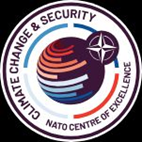Project CASA Report explores the growing demand for military involvement in climate emergencies worldwide

Photo: 05 July 2025 - The United States Coast Guard (USCG)- continues to assist the state of Texas with flooding near Kerrville. USCG MH-65 helicopters have conducted 12 flights to the flooded area, rescued 15 campers from Camp Mystic in Hunt, and aided in the evacuation of 230 people. Source: See below.
Brussels / The Hague - 12 September 2025
By Ronald A. Kingham and Dr. Ashley McIlvain Moran [1]
Growing Climate Pressures
The frequency and intensity of extreme weather events, such as wildfires, floods, and hurricanes, have dramatically surged in recent decades. The World Meteorological Organization notes a nearly five-fold increase in climate disasters between 1970 and 2021, resulting in over two million deaths and US$4.3 trillion in economic losses. Such figures represent an accelerating systemic crisis where the rate of climate impact is outstripping current adaptive and response capacities.
Increasingly, militaries are called on to support civil defence authorities to fill critical gaps. Their logistical expertise, rapid mobilization capabilities, and experience operating in high-stress environments make them indispensable partners in emergency response efforts when civilian capacity is strained. While foundational international guidelines like the Oslo Guidelines traditionally suggested military assets be used as a “last resort,” the escalating scale of climate emergencies increasingly challenges this principle, leading to a de facto normalization of military involvement.
Yet there has been no systematic, cross-national data on military involvement in such disasters, making it difficult to assess the extent and evolution of civil-military cooperation in climate emergencies. This presents a major challenge for militaries and policymakers alike needing to plan and prepare for varied state missions and ultimately protect their people.
Bridging the Data Gap
A global collaboration - Project CASA (Climate and Security Action through Civil-Military Cooperation in Climate-Related Emergencies)—was launched in 2023 to address the need for coherent data on military involvement in natural disasters and thus help improve civil-military response. The project’s Coordinating Group reflects a collaboration between five partner organizations across military, government, academic, and civic institutions: the Climate Security Association of Canada, the Crisis Management and Disaster Response Centre of Excellence, the Environment & Development Resource Centre, the Foundation for Global Governance and Sustainability, and the Global Military Advisory Council on Climate Change.
The end result is a groundbreaking report- Resilience, Readiness, and Response - that serves as both a critical resource and a call to action for policymakers and practitioners grappling with climate-worsened disasters. Based on global data collection and country surveys completed by military and government officials and non-governmental experts, the report examines trends in military responses over time, the resources and mechanisms used by militaries, and the consequences for force structure and readiness.
Diverse Approaches to Civil-Military Cooperation
The study reveals a wide spectrum of approaches among countries facing varied types of climate security risks, budgetary constraints, military and civilian agency structures, and national contexts—shared with the goal of learning from each other as all states face growing climate challenges and a potential need to take new steps outside of what has worked in the past.
- Legal and Policy Frameworks: Some countries, like Bangladesh and Sweden, rely on general national disaster frameworks without specific military guidelines, while others, such as Hungary, Ireland, and Italy, have extensive laws and military policies. Belgium, Brazil, Bulgaria, Canada, France, Latvia, Mexico, Romania, Spain, Switzerland, and the United States have robust legal frameworks and military guidelines covering climate change mitigation, adaptation, and disaster response. Croatian Armed Forces is currently developing a climate change mitigation and adaptation plan which it expects to adopt by the end of 2025.
- Operational Frameworks: Approaches range from training specialized personnel within regular units (e.g., Romania, Italy, Pakistan) to creating specialized stand-alone units (e.g., France, Spain, Bulgaria, Canada's DART) or engaging the full military (e.g., Bangladesh, Ireland, Sweden). Brazil even utilizes "dual-use" units for both civil protection and general military missions.
- Military Training: Training varies from specific tasks like search and rescue or CBRN hazards for specialized personnel (e.g., Croatia, Ireland, Latvia) to full-force training on civil protection generally (e.g., Bangladesh, Sweden). Notably, some countries like Canada, France, and Spain maintain permanent training schools for natural hazard response.
- Roles and Responsibilities: Militaries are most often involved in the early stages of emergency response, providing services like firefighting, flood response, and immediate relief, engineering, and security. Civilian agencies typically focus on longer-term processes such as prevention, preparedness, and recovery. However, there is variation in who handles search and rescue, medical assistance, and infrastructure restoration. Many countries emphasize that military engagement is at the request of civilian authorities, maintaining civilian primary responsibility.
- International Coordination: The report identifies wide participation in mechanisms like the EU Emergency Response Coordination Centre, NATO Euro-Atlantic Disaster Response Coordination Centre, and the UN Office for the Coordination of Humanitarian Affairs. Countries like Bangladesh and Pakistan also participate in UN Peacekeeping Operations and regional organizations.
Advantages of Military Contributions
Countries identify several benefits of significant military involvement in civil protection, including:
- Rapid mobilization and deployment: Militaries can quickly move personnel and equipment to affected areas.
- Logistical and engineering capacity: Militaries possess significant resources for transportation, infrastructure repair, and setting up temporary facilities.
- Operating capacity in austere conditions: Militaries are trained to function effectively in difficult terrain and high-stress environments.
- Positive public perception and morale: Military involvement in disaster response boosts public trust in the military and enhances troop morale, as responses provide direct support to populations in a time of need.
- Skills sharpening: These operations can refine core military skills like command and control and interagency coordination in a real-life, non-combat setting, thus potentially increasing military readiness.
Disadvantages of Military Involvement Countries also identify several drawbacks to military involvement in civil protection, including:
- Diversion from core missions: Increased military involvement in climate emergencies diverts resources and personnel and thus risks undermining the military’s primary responsibility for national defence.
- Strain on personnel and equipment: Frequent deployments can lead to fatigue, stress, and wear and tear on both human and physical resources, thus potentially decreasing military readiness.
- Potential for critical gaps: Over-reliance on the military could create vulnerabilities if the military is deployed for other national defence missions and civilian agencies are not adequately prepared to handle major disasters independently.
Countries also note that civilian agencies offer distinct advantages, including closer ties to local communities, specialized expertise in social services and psychosocial support, and a longer-term perspective focused on prevention, preparedness, reconstruction, and economic development. Citizens themselves are also seen as a critical “first line of defence” when it comes to preparing for and responding to a range of emergency situations.
The Imperative for Better Data and Coordination
A central finding of Project CASA is the severe lack of systematic, cross-national data on military involvement in climate emergencies. The study compares three sources of data—first, OECD DAC, as the only current international reporting mechanism tracking humanitarian assistance and disaster response; second, national reporting of all foreign responses; and third, national reporting of all domestic responses—identifying military responses to climate emergencies in each of these data sources. This reveals that current international reporting mechanisms significantly undercount military outlays in disaster response, particularly for domestic emergencies.
For example, for the 2012-2022 years available in all three data sources and looking only at the United States, the OECD DAC data captures only 18 U.S. military responses to climate emergencies in developing countries, costing US$24.9 million, while U.S. Foreign Assistance data reveals 19 cross-border U.S. military responses to climate emergencies at a cost of US$54.7 million. But national U.S. FEMA data reveals 3,060 U.S. military responses to climate emergencies domestically over the same period, costing US$14.8 billion.
The study concludes with several key recommendations for action at national and international levels:
- Track detailed military response data: National governments should systematically collect and publish detailed data on all domestic and foreign emergency responses, including crisis type, responding agency, response activities, and dates.
- Compile cross-national data: International organizations like the OECD, NATO, EU, or UN bodies should enhance data collection to provide a more comprehensive global picture of military involvement in climate emergencies.
- Enhance integration of response data: Early warning systems should incorporate environmental, public health, and security indicators, leveraging diverse sources from scientific data to data from local monitoring networks and indigenous knowledge.
- Integrate strategic climate intelligence: Civil-military frameworks should shift from reactive to proactive approaches, using foresight and scenario planning to anticipate cascading risks.
- Promote participatory scenario planning: Civil-military frameworks should involve diverse military, civilian, and community stakeholders in scenario development.
- Prioritize collaborative, interdisciplinary approaches: Formal collaborative governance structures and interdisciplinary training should be established for improved coordination and culturally sensitive engagement.
- Strengthen civil-military partnerships throughout the DRR cycle: Militaries should consider their roles in preparedness and recovery, identify the partnerships needed with civilian agencies and communities, and build this into planning.
- Facilitate learning and exchange: Intergovernmental organizations should convene international forums to share lessons learned and good practices across countries and international mechanisms.
In essence, the Project CASA report argues that effective cooperation, coordination, and information sharing among all levels of government, the military, local communities, civil society organizations, and international humanitarian organizations are paramount to addressing the growing climate crisis. The report includes detailed country profiles, international / intergovernmental organization profiles, a new dataset on military responses, and a typology of civil protection activities—all to provide more comparative data on military involvement in climate emergencies across the prevention, preparedness, response, and recovery phases.
We hope that Project CASA and this report can help stimulate further study and interaction to meet this defining challenge of our time.
[1] Ronald A. Kingham is Executive Director of the Environment & Development Resource Centre (EDRC), Co-coordinator of the Brussels Dialogue on Climate Diplomacy, and Coordinator of Project CASA and the Global Military Advisory Council on Climate Change (GMACCC). Dr. Ashley McIlvain Moran is a Research Scientist at the University of Texas at Austin (UT) and a Member of GMACCC. She previously directed UT’s climate security research programs funded by the U.S. Department of Defense and the USAID Office of Conflict Management and Mitigation.
 | Resilience, Readiness, and ResponseReport of the project on Climate and Security Action through Civil-Military Cooperation in Climate-Related Emergencies (Project CASA) |
>>> READ MORE AND DOWNLOAD THE REPORT >>>
Project CASA is led by a Coordinating Group composed of 10 representatives from the five Partner Organizations:

- Climate Security Association of Canada (CSAC),
- Crisis Management and Disaster Response Centre of Excellence (CMDR COE),
- Environment & Development Resource Centre (EDRC),
- Foundation for Global Governance and Sustainability (FOGGS), and
- Global Military Advisory Council on Climate Change (GMACCC).
With the participation of the Project CASA Advisory Group and Expert Group.
 | Project CASA is supported by the Directorate of Strategic Coordination and Outreach of the Canadian Department of National Defence through its Mobilizing Insights in Defence and Security (MINDS) Program and by the NATO Climate Change and Security Centre of Excellence (CCASCOE) |  |
Article Lead Image Credit: Source: https://x.com/USCGHeartland/status/1941569535238340640/photo/2 By Unknown author - Public Domain, https://commons.wikimedia.org/w/index.php?curid=169349794
Report Cover Image credit: Sergeant André Hotton, a search and rescue technician, prepares to release marker streamers from a CC-130 Hercules aircraft on a 2018 exercise. PHOTO: 14 Wing / Government of Canada News Article / October 13, 2020